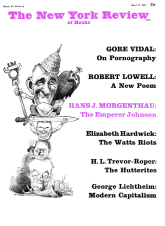In response to:
Hart Crane from the January 20, 1966 issue
To the Editors:
Edward Dahlberg’s review of Hart Crane’s letters (Jan. 20) is the finest piece on Crane that I have read. The elusiveness of the man (and poet) and his desperate “bedlamite shrieks of a soul sunk like Atlantis” (Dahlberg) as well as Crane’s “green sea cries towering out of the foam,” are suddenly and unexpectedly revived. It is as if Crane himself had come to disturb us again, reeling into a room, into a cafe, tender, effusive, outraged, outcast.
There is one correction I would like to make in this article of Edward Dahlberg’s, and one question I would like to ask. The correction is this: the “castle” to which Harry Crosby invited Hart Crane, and where he hoped he would finish writing “The Bridge,” was actually a mill. It was situated close to Paris, on the estate of the Rochefoucaulds and it was the mill which, in other centuries, had ground the flour for the nobility thereabouts. It was known quite simply as “Le Moulin,” and Hart Crane and I made numerous visits there. But, despite its simplicity, it was not an easy place to work in. The company of other writers, of painters, and sculptors, and of visiting celebrities, made it a much too diverting place.
The question is this: Did Crane really end his life because, as Edward Dahlberg writes, he could not, on that return trip from Mexico, face the reality of himself “once more as a penniless urchin in New York”? Was it not, rather, that Crane, so desperately eager to accomplish the work that would establish his right to be our myth, came back from Mexico with the Guggenheim year a lost year behind him—returned, that is, without the only thing he wanted, and that we hoped for, the poem he had dreamed of, talked of, written of, and did not write? I believe he could have faced (to quote Dahlberg again) “the ignominy of level, average days” had the poem been there on paper instead of closed in jubilant anguish in his heart.
Kay Boyle
San Francisco
This Issue
March 31, 1966



